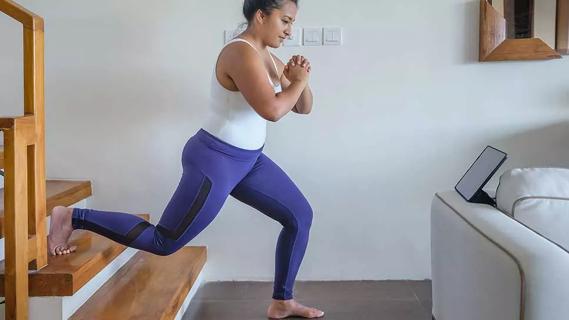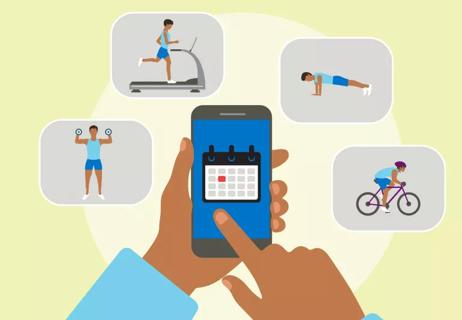For fitness success, set goals that are specific, measurable, attainable, relevant and time-bound

We know that keeping ourselves physically fit is important. Regular exercise is good for our minds and our bodies. And whether you’re a dedicated fitness buff or just getting started, it turns out that your fitness routine could benefit from taking a cue from the business world.
Advertisement
Cleveland Clinic is a non-profit academic medical center. Advertising on our site helps support our mission. We do not endorse non-Cleveland Clinic products or services. Policy
Specifically, setting goals. And — even more specifically — setting SMART goals.
SMART is an acronym for goals that are:
“SMART fitness goals are a framework for how you’re going to achieve certain results,” says exercise physiologist Katie Lawton, MEd. “If we don’t have something that we’re moving toward or a plan to get there, we can get lost and lose motivation. Setting SMART fitness goals allows you space to consider what you really want to achieve in your exercise program, and by when.”
We talked with Lawton about what SMART fitness goals are and examples of how you can improve your health by starting with thoughtful goal setting.
SMART goals are a way to systematically and thoughtfully approach an objective. They were first introduced by business consultants in the 1980s to help employees define (and ultimately, meet) their work objectives, but the approach extends beyond office culture.
Think about it like this: If a business owner’s goal for the next quarter is to “make more money,” that doesn’t tell you how they’re going to get there or how much cash they want to bring in. It’s not a solid plan for success.
Similarly, a fitness goal to “get healthier” doesn’t give you a useful blueprint to work from.
Advertisement
That’s where SMART goals come into play.
“If you don’t have a defined goal and a plan to reach it, you can start at a program, but you’re likely to be all over the place — not focused and maybe even unmotivated,” Lawton says. “Setting specific, measurable goals can provide a ‘spark’ and hold you accountable as you work to improve your fitness level.”
Lawton explains how to set goals to work out SMARTer, not harder.
Let’s start with this example SMART fitness goal:
In the next three months, I will increase my current average step count from 6,000 steps per day to 8,000 steps per day.
A goal to improve your average number of steps per day is targeted and specific. More than a plan to “walk more,” this goal includes starting point and a target expectation.
SMART fitness goals need to be trackable — otherwise, how can you know if you’re achieving the desired result? And how do you know when you get to back yourself on the back for a job well done?
In the above example of increasing steps per day, you have a certain number of steps to work toward. And using a pedometer or other step-counting device, you can measure how you’re moving toward meeting that goal.
If you’re new to consistent exercise, it’s not very likely (or advisable) to plan to run a marathon in a month. Setting goals that are within an achievable range will help ensure that you have the proper motivation to reach them and that you’re setting yourself up for success.
“If you set your sights too high, too fast, it’s easy to get frustrated and give up,” Lawton states. “You can also injure yourself if you’re trying to push too far to reach an unreasonable goal.”
In this example, the goal to increase steps by an average of 2,000 steps per day can be attainable, yet it’s a big enough change that you’ll need to push a little harder than usual in order to achieve the goal.
Whether a fitness goal is attainable depends on where you’re starting from in your fitness journey, how much time and energy you have to devote to your new routine, and how motivated you are to achieve your goal.
Setting a relevant SMART fitness goal means thinking about the ends you’re trying to achieve and finding the path to get there.
If your reason for increasing your step count is to achieve an overall improvement in your health, you’re on the right track. Walking can burn some extra calories, relieve stress, improve your energy and more. If those are the kinds of benefits you’re looking for, you’re on track with a relevant workout goal. Congrats!
But if what you’re really working toward is increased flexibility to relieve pain in your shoulders, the step-count goal won’t really get you there. A more relevant goal would focus on incorporating more stretching or yoga into your day.
Advertisement
A time-bound goal means setting a timeframe, sometimes even a specific date that you can circle on your calendar, by which you plan to have achieved the goal. Adding a time-sensitive element to your goal means you’ll be able to plan the incremental changes you need to achieve the goal and set milestones along the way.
Because SMART goals take into account your current fitness level and your personal desires, goals are likely to be very different from person to person. That’s what makes them personalized and more likely to make you successful in sticking to them and achieving results.
In general, short-term fitness goals should be things you plan to achieve in the next six months or less. Anything longer than that is considered a more long-term goal.
Consider these example SMART fitness goal examples to get you started on setting your own goals.
Short-term: By fall, I’ll run a 5K.
Long-term: This time next year, I’ll run a 10K.
Short-term: For the next six months, I’ll go to two yoga classes per week.
Long-term: By this time next year, I’ll work on advanced poses in higher-intensity yoga classes.
Advertisement
Short-term: I’ll be able to do 25 knee push-ups in a row without being fatigued in the next three months.
Long-term: In a year, I’ll do 50 regular pushups in a row.
OK, so now it’s all out there on paper. You’ve set a solid SMART goal and have a reason to push yourself to new limits. (Yay!) Now comes the real work.
Lawton says that accountability is the key to achieving the goals you set out for yourself.
“Sometimes, people don’t appreciate how much work actually goes into actually meeting their goals. Changing your habits can be intense and uncomfortable, but it’s worth it. It’ll help to have a plan in place not only for what you’re going to achieve but also the steps you’re taking to get there.”
Lawton suggests these ways to track your progress toward meeting your fitness goals:
Advertisement
Working toward a new goal can be exciting, and maybe even daunting. But breaking it all down into short-term plans and long-term goals that are attainable and measurable can help take some of the guesswork out of the equation. And it keeps you physically and mentally on track to make changes in your life.
If you’re still not sure where to start or are looking for advice, Lawton suggests talking with a fitness professional — like a fitness coach or personal trainer — to help you set a SMART goal, make a plan to achieve it and give you a nudge along the way.
Learn more about our editorial process.
Advertisement

The exercise — which you’ve probably been doing since grade school — can be intimidating, but proper form can help

Exercise lowers risk for heart conditions, improves mental health and reduces visceral fat that can compromise your organs

Ask questions, get referrals and consider if someone is a good fit for you and your fitness goals

Expect a few bumps in the road, work out for the right reasons and give yourself some credit

Jump into the swing of things to improve your coordination, burn calories and get your heart rate going

Walking with a weighted backpack is a low-impact, full-body workout that’s growing in popularity

A super high heart rate means you’re burning more than fat

Meet your workout goals by accounting for frequency, intensity, time and type

Type 2 diabetes isn’t inevitable with these dietary changes

Applying a hot or cold compress can help with pain